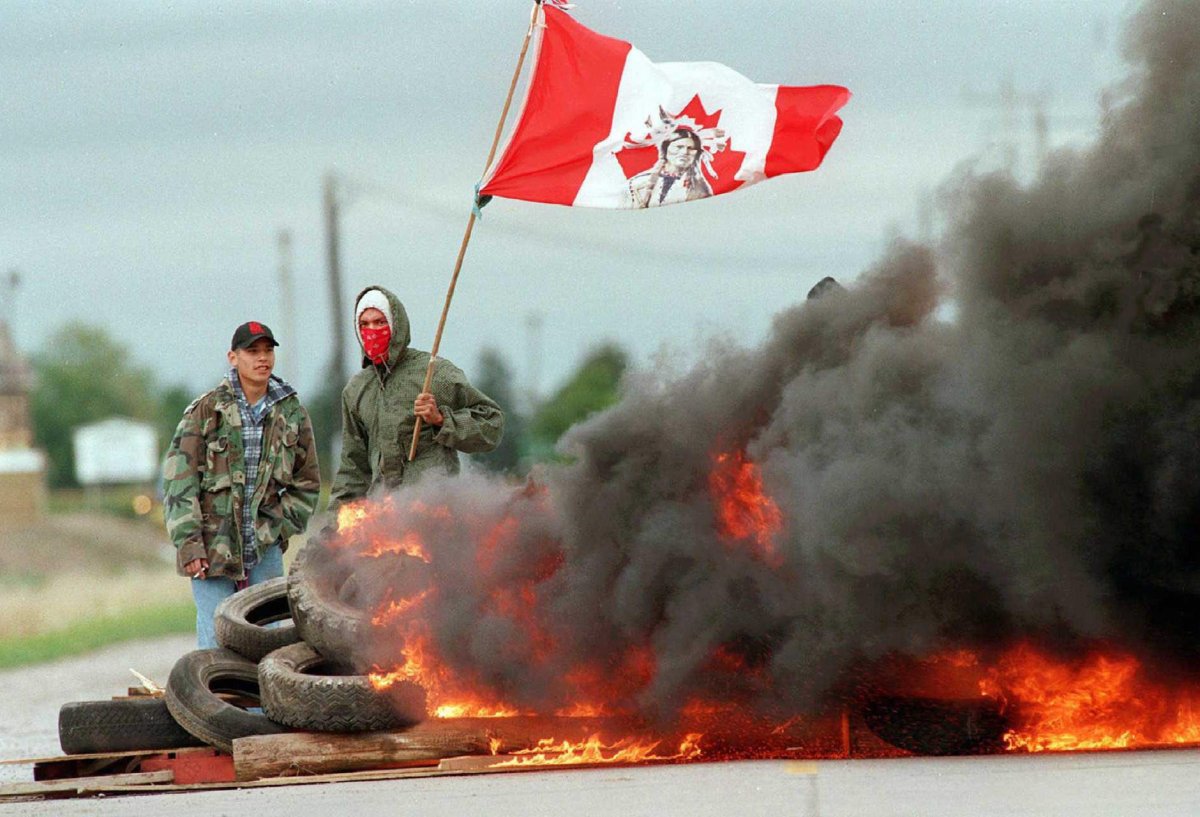A new exhibit is being launched Saturday at Museum London to mark the 25th anniversary of the Ipperwash Crisis and the shooting death of protester Anthony (Dudley) George at the hands of police.

The multimedia exhibit, Gaawiin Ogiibaagininaawaasiin — roughly translated from Anishinaabemowin to English as “they did not let it go” — is being co-curated by Summer Bressette and Monica Virtue and is set to run until Jan. 24.
Those visiting the museum will see items that will “frame the events at Ipperwash within a long history of colonial coercion, government inaction, and Indigenous resistance,” according to the museum.
The museum describes the exhibit as highlighting the “notable resistance and consistent lack of consent on behalf of the Anishinaabeg to surrender their homeland, their bodies, and their images to colonial power.”
“It certainly became something more than just telling the story about 1995,” said Andrew Kear, the museum’s senior curator and head of exhibitions, who appeared Friday on 980 CFPL’s The Afternoon Show with Jess Brady alongside Virtue.
“Very quickly, we realised that it had to tell the story about 1763, the Royal Proclamation, all the way up to the present where … there’s actually engagement with people in the community who experienced Ipperwash and reflecting on what it means 25 years later.”
- Most Canadians now want early election as Trudeau support drops again: poll
- NDP will vote to topple Trudeau and propose confidence vote, Singh says
- This Canadian is his school’s first medical student in a wheelchair. He’s thinking big
- National Bank gets final approval for Canadian Western Bank takeover
The Ipperwash Crisis began on Sept. 4, 1995, after members of the Chippewas Kettle and Stony Point First Nation occupied what was then Ipperwash Provincial Park as a protest against nearby reserve land that had been seized by the Canadian government during the Second World War.
Despite the objections of Stony Point residents, the government appropriated the land in 1942 under the War Measures Act to set up a military training camp — Camp Ipperwash.

Get daily National news
More than a dozen families from Stony Point were moved to nearby Kettle Point, with the government promising to return the land after the war, a promise that was broken when the military chose to keep the facility open.
Following several failed attempts to negotiate the return of the lands to the First Nation over the subsequent decades, members of the First Nation, many descendants of those who were forced to relocate in the 1940s, began an occupation of the property in 1993.
Two years later, in September 1995, a splinter group of about 30 protesters occupied nearby Ipperwash Provincial Park, saying it contained a sacred burial ground. For two days, protesters and police faced off as authorities attempted to remove the occupiers from the park.
On the night of Sept, 6, members of the OPP’s tactical response unit opened fire on a group of protesters as they attempted to leave the park.
Dudley George was shot and killed by an OPP sniper in the process.
Sgt. Ken Deane, one of the officers in charge of the sniper team, would later be found guilty of criminal negligence involving death. He did not serve any prison time and died in a car crash in February 2006.
Among the items on display at the exhibition are interviews with five First Nation community members reflecting on the Ipperwash Crisis a quarter-century later. One of the interviews is with Dudley George’s older brother, Pierre.
Other items include artwork by Anishinaabe artist Robert Houle, photographs, and colonial maps that have been altered to include original place names in Anishinaabemowin — an idea proposed by Bressette.
“Once we got into that, I realised we also had an opportunity to try and educate people about how the land was stolen in the first place, which is really quite complicated,” said Virtue.
“Canadians aren’t used to talking about these conflicts in terms of the law and what that actually means. I don’t know how successful I’ve been, I’m really curious to hear that feedback of people who visit the exhibition to see whether I’m actually communicating through the maps, what I want to.”
The exhibit also includes four replicas of the wampum belts from the Treaty of Niagara in 1764.
“We’re hoping by the time people begin at the beginning, look at the wampum and understand what wampum are about, then look at the five maps, and then move on to the stories from community members about how we’ve broken our promises that were exchanged over wampum,” Virtue said.
“How we’ve used our colonial laws to get around those promises and then get around the treaties themselves using the Indian Act. The voices of community members are actually articulating the damage that’s done, the trauma that that has caused that community.”
A public inquiry into the Ipperwash Crisis, released in 2007, found Ontario’s then-premier Mike Harris and the federal government responsible for George’s death. Inquiry commissioner Sidney Linden called for the disputed land to be returned.
In 2016, Ottawa signed an agreement to return the former Camp Ipperwash to the First Nation, along with $95 million in compensation to “invest in a brighter future.”
Because of the site’s past as a former military training camp, the grounds are littered with unexploded ordinances and environmental dangers, such as contaminated soil. As part of the agreement, the former camp lands, vacated by the military in1995, would be safe and environmentally sound upon return to the First Nation.
Work cleaning the grounds has been ongoing for years and is expected to take another 25 years, with land transferred in parcels.
In 2009, the province signed an agreement to transfer the former provincial park back to aboriginal hands once years of environmental and archaeological studies and clean-up had finished.
The First Nation had long argued the park was part of the original Stony Point Reserve, an unceded tract of land established in an 1827 treaty but whose history with aboriginal groups goes back thousands of years.
Just over 113 acres of parkland was officially returned to the First Nation late last month, more than a decade late, as an addition to the reserve. The province had to first transfer the lands to the federal government in July, which then returned the lands to the First Nation.
“The return of the former provincial parklands is an important legal indicator for our ancestors and our future generations that we’re home again and the land is legally ours,” said Jason Henry, chief of Chippewas of Kettle and Stony Point First Nation.
“The return of this portion of the lands is but a small portion of what was lost and although the process is not perfect, it gives hope that in the future we may see the full return of Aazhoodena (Stony Point).”
— With files from The Canadian Press












Comments